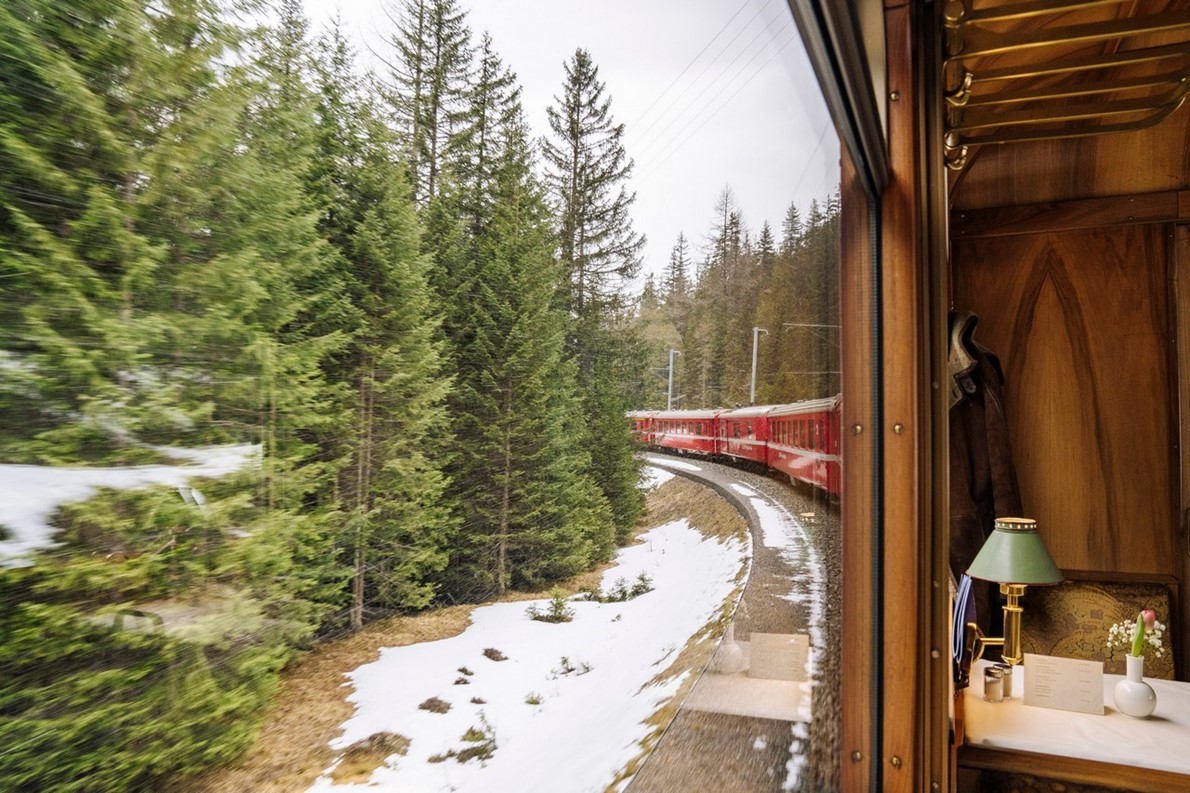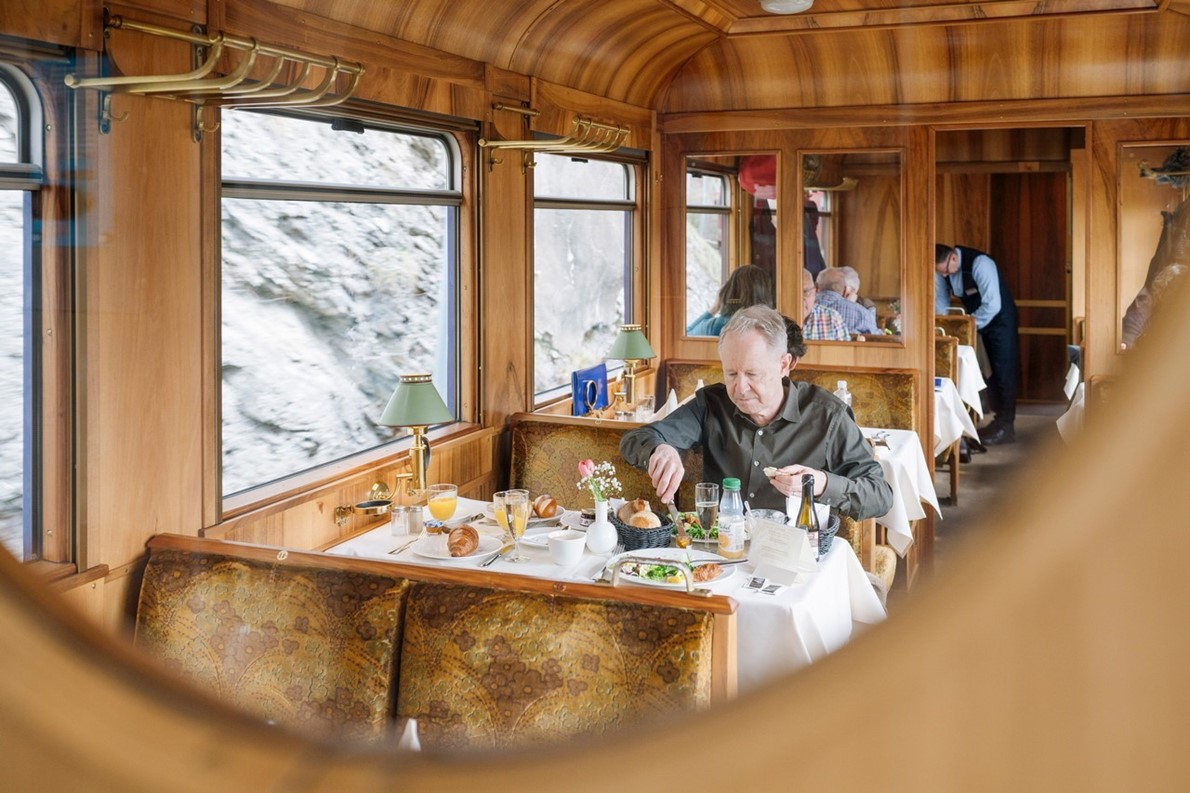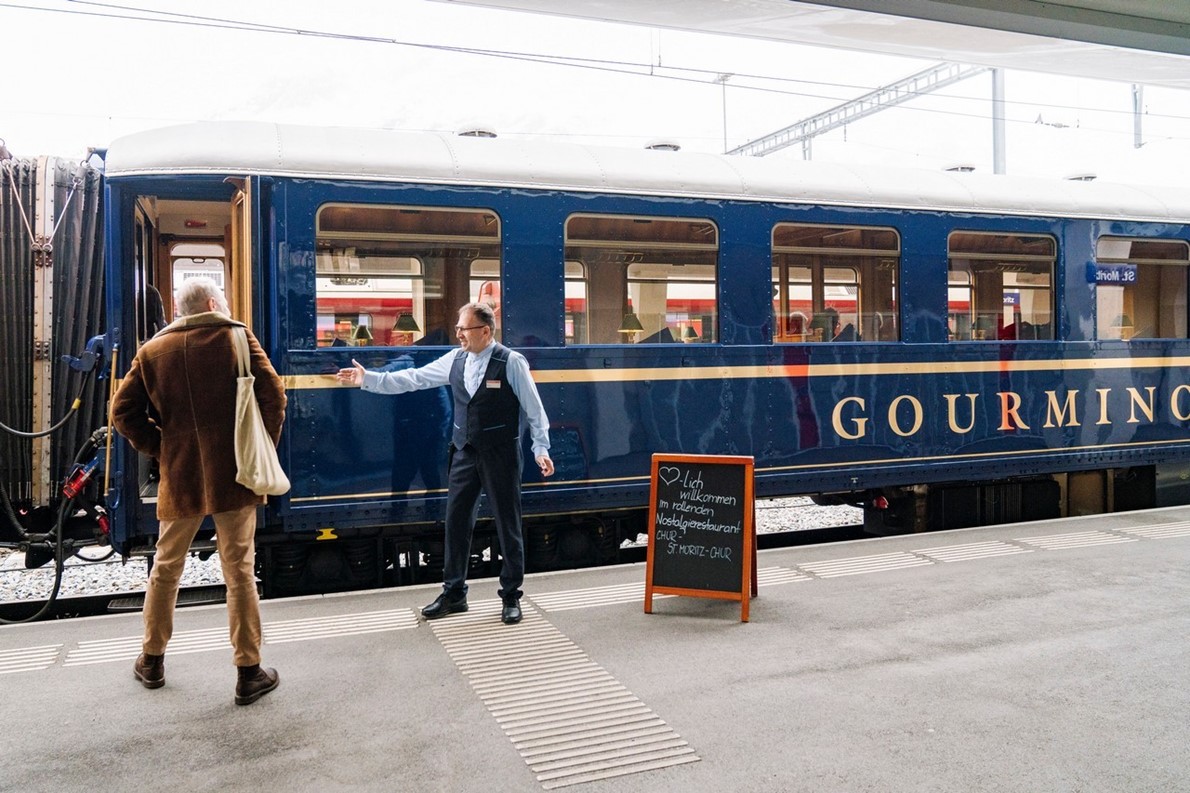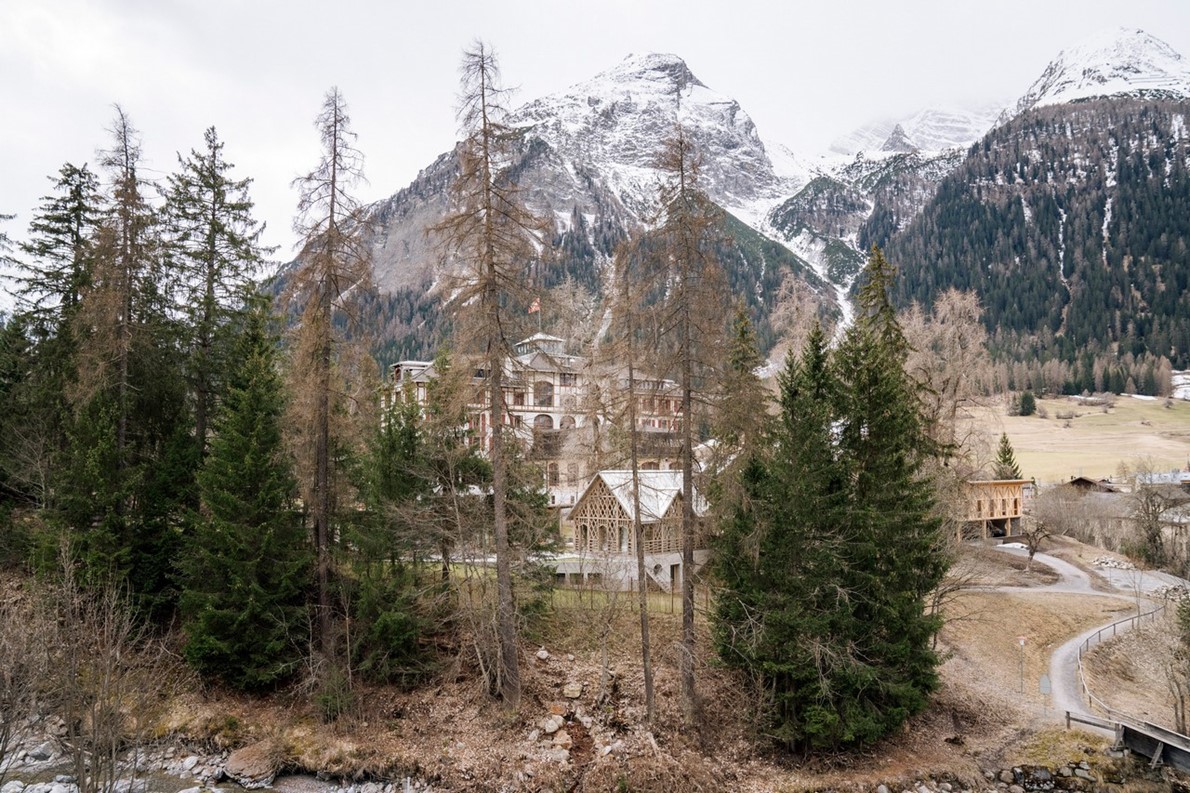It was a familiar sound in any
decent central European restaurant: the reassuring whack-whack-whack of a chef
flattening the schnitzel I had ordered from the waiter a minute earlier. The
crisp white tablecloth in front of me shined bright white, and the banquette
seating offered the same minimalist design as some of the region’s trendiest
spots. But one aspect was different from my other recent fine-dining
experiences: In the panoramic window facing my table, an Old World landscape
was flying by at over 140kph.
اضافة اعلان
 A view from Rhaetian
Railway’s Gourmino dining car traversing the countryside in Switzerland.
A view from Rhaetian
Railway’s Gourmino dining car traversing the countryside in Switzerland.
I was in the dining car of a train, halfway
from my home in Prague to an event in Budapest, Hungary. Despite the great
service and cool decor, the meal was wildly better than I had any right to
expect: a crisp, improbably thin, fried chicken fillet, tender on the inside,
accompanied by the Platonic ideal of potato croquettes and a craft beer that
had been custom-brewed for the train. It was not just good. It was spectacular.
Much like the renaissance of night trains,
dining cars are blossoming in Europe. Instead of the tired fare of previous
eras, many now offer seasonal menus that highlight regional recipes and local
producers. On some trains, the standards are quite high, although prices are
generally affordable, with main courses often starting around 12 euros (about
JD9).
On social media, fans share photos of their favorite onboard meals. Connoisseurs argue over which railways have the best menus, rooting for Polskie Koleje Państwowe in Poland, Deutsche Bahn in Germany, or Czech Railways, where I had had my schnitzel epiphany.
The public has caught on. On social media,
fans share photos of their favorite onboard meals. Connoisseurs argue over
which railways have the best menus, rooting for Polskie Koleje Państwowe (PKP)
in Poland, Deutsche Bahn in Germany, or Czech Railways, where I had had my
schnitzel epiphany. It is completely unlike the situation in the US, where
Amtrak killed off most dining cars on train routes east of the Mississippi
River in 2019.
To learn more, I reached out to David Ecker,
who runs the @_DiningCar Twitter account from his home in Vienna. The food on
European trains seems to be flourishing in central and Eastern Europe, he said,
while dining cars have become a rarity in much of Western Europe.
“I think in central and Eastern Europe, you
get the best experience,” he said. “But, of course, if you’re looking for the
highlights, then you have to go to Switzerland.”
With a few tips from Ecker, I planned a
trip that would allow me to sample a handful of dining cars, routing my journey
through Vienna, since much of the renaissance in European train travel seems to
be driven by Austria’s national railway, ÖBB. From Prague, I would retry the
Czech Railways dining car, then connect to a Polish train with a WARS dining
car. After an overnight stay in Vienna, I would take the superfast ÖBB Railjet
train to visit a friend in Zurich and take a train to the Alps. Later, I would
head home while sampling the meals on Germany’s national railway, taking
Deutsche Bahn’s speedy InterCity Express (ICE) trains.
 A Rhaetian Railway
passenger enjoys the fisherman’s breakfast of smoked trout, Prosecco, coffee
and croissants.
A Rhaetian Railway
passenger enjoys the fisherman’s breakfast of smoked trout, Prosecco, coffee
and croissants.
Before I left, I loaded the
Eurail/Interrail Rail Planner app onto my phone and bought a five-day,
first-class adult train pass for 376 euros. I looked up dining-car menus
online, booked a couple of hotels along my route, then packed my bag and walked
to Praha Hlavní Nádraží, the Czech capital’s main train station, skipping lunch
to ensure I had a healthy appetite.
Schnitzel, goulash and Moravian wineI was not the first passenger in the dining
car en route to the Czech Republic’s eastern city of Ostrava, which was how I
hit my first snag. I wanted to order an updated Czech classic — pork roast with
grilled zucchini and spinach — but the charmingly goofy young waitress happily
informed me that the last two portions had been ordered by the burly gentlemen
nursing the first of many bottles of Pilsner Urquell beer at the next table
over. Cruelly, they had also taken the last portions of the cream of carrot
soup with tarragon.
Outside the window was a series of photo-worthy viaducts, tunnels, bridges, and mountain peaks, intensified by the exquisite cuisine and historic decor inside.
I opted for goulash, as well as another
schnitzel — pork this time — with potato salad. As the barren fields of the
central Czech countryside gave way to the snowcapped hills of the
Bohemian-Moravian Highlands, I cooled down with one of the train’s unique
drinks: a New England-style pale ale from the craft brewery Pivovar Chroust,
brewed in partnership with another local maker, Pivovar Falkon, exclusively for
the JLV dining cars on Czech trains and available nowhere else. Super fruity
and very low in bitterness, it was an excellent, mood-elevating aperitif.
There was nothing wrong with my goulash
either: served hot, filled with chunks of tender beef and potatoes wrapped in a
thick, paprika-inflected broth. The pork schnitzel that followed seemed like a
step down from the transcendent version that had inspired my interest — crunchy
enough on the outside but not as tender inside. The potato salad redeemed the
meal, echoing my grandmother’s recipe: a tower of well-cooked potato cubes,
larded with pieces of dill pickles, boiled egg, and tender carrots, bound
together in a rich mayonnaise dressing.
Another exclusive bottle took things to
another level: Znovín Znojmo Kerner 2020, a late-harvest semi-dry wine from the
country’s eastern region of Moravia. Moravian whites have gained a buzz in the
US in recent years, and I could see why. Descended from riesling and
trollinger, the kerner grape showed off flinty mineral notes with a touch of
raisins and honey — like its parent riesling, but with its own style. I left
the train feeling satisfied, not least because of the price: the whole meal
came out to 412 Czech koruny, or about JD13.5.
Paprika chicken and organic beerAfter an hour at the station at Ostrava, I
was ready to see how a Polish dining car would compare. But when I boarded the
PKP train, I learned an important lesson about dining cars. “I guess they left
it in Poland,” the conductor replied, when I asked where our train’s dining car
might be. Three hours later, I disembarked at the main station in Vienna,
famished.
 Head waiter Mio Maric greets Rhaetian
Railway passengers boarding the Gourmino dining car in St. Moritz, Switzerland.
Head waiter Mio Maric greets Rhaetian
Railway passengers boarding the Gourmino dining car in St. Moritz, Switzerland.
That was the only disaster I experienced.
After a dreamy night at the city’s new Hotel Josephine, I stopped for a light
breakfast at the historic Viennese coffeehouse Café Sperl in preparation for
lunch aboard the ÖBB Railjet to Zurich.
The flat landscape outside Vienna gave way
to hills, followed by mountains. I sent my son a photo of the display showing
the train’s speed as 233kph. It felt like we were on a plane, although the
seats were more spacious.
As new and shiny as it appeared, the dining
car was less enjoyable than the older Czech Railways version in many regards,
with fewer seats, a plastic feel, and no tablecloths — crisp, white, or
otherwise. Service was less attentive, too, reflected in the lukewarm
truffle-celery soup, which was otherwise creamy and filling, hinting of nutmeg
and underplaying the truffle-oil notes. A regional main course, kärntner
ritschert, improved things: a rib-sticking, cassoulet-like stew of pearl
barley, white beans, and smoked pork morsels from the Austrian region of Carinthia,
near Italy and Slovenia. Fragrant with marjoram and parsley, it put a point on
the ÖBB scoreboard. Another plus was the remarkable Domäne Wachau Riesling
Federspiel Terrassen 2022, a white wine from Austria’s Wachau region on the
Danube, featuring intense stone-fruit, lime, and pear notes.
As the scenery gained elevation, I watched
for snow but saw very little until after Innsbruck. Once the sun was behind the
mountains, I ordered supper: organic paprika chicken with spaetzle and a local
organic beer, Schladminger Bio Zwickl. I did not mind the cold temperature on
the lager, but I would have preferred the chicken warmer, and with fewer
crunchy bits of cartilage, or whatever it was that was not meat. It had a
flavorful, creamy sauce, however, that soaked nicely into the pasta.
Overall, it was a decent effort, and I
appreciated that the Austrian menu also listed vegetarian and vegan options.
But my meals suffered from the Railjet dining car’s atmosphere and lackluster
service, and as I left the train station in Zurich, I was already looking
forward to my trip through the Alps the next morning.
Smoked trout and proseccoAt first it seemed like Zurich had not
changed much since my last visit 30 years earlier. But I noticed a number of
new buildings as our train slipped out of the city, sliding under the sunrise
alongside Lake Zurich toward Chur, where my next connection waited.
I still had not eaten on trains in Romania or Serbia, which many fans loved, and somewhere out there was a Polish dining car with my dinner on it.
Across the platform, I spotted the scarlet
cars of the Rhaetian Railway, and the wood-lined, century-old dining car of a
transalpine train known as the Gourmino.
The waiter welcomed me graciously,
extending his hand for me to choose any table I liked in the vintage-1920s
dining car. It was just before 9am when we departed. A few minutes later, I was
sampling the first bites of my fisherman’s breakfast: cold fillets of smoked
trout, warm rolls, butter, jam, honey, prosecco, and coffee, along with a
croissant so hot, crisp, and flaky that I thought it might have been
deep-fried.
It was an experience of another order, as
Ecker had said. The tablecloths were cream-colored, not white, and felt soft
and smooth instead of crisp and starchy. Tiny lamps illuminated each table,
with foldable metal hoops next to them — to hold Champagne bottles, I imagined.
It felt like the love child of the Orient Express and a midcentury ski chalet,
with six four-seat booths and five two-seat tables furnished in shiny wood
paneling and thick brocade fabric. I sipped my prosecco, ate a bite of buttery
smoked trout, and counted my blessings as the train rose into snowy peaks of
the Alps on our two-hour journey to St. Moritz.
After disembarking in St. Moritz, visiting
the museum dedicated to painter Giovanni Segantini, and sightseeing for a few
hours, I boarded a different Gourmino train back to Chur. It offered more of
the same, only better.
For lunch, I chose the three-course, prix
fixe menu and a glass of Von Salis Heidi-Wii Maienfelder Blanc de Noir, an
elegantly dry white wine. The service was impeccable, with palpable attention
to detail. The buttery potato-leek soup arrived steaming hot. Chicken
stroganoff included yellow heirloom carrots, perfectly cooked, a snowball of
short-grain rice, and a pepper-scented sauce. For dessert, the flaky,
caramelized apple pie split the difference between an Old World tart and the
“as American as” recipe.
Outside the window was a series of
photo-worthy viaducts, tunnels, bridges, and mountain peaks, intensified by the
exquisite cuisine and historic decor inside. Announcements in English and
German explained that our route was part of a UNESCO World Cultural Heritage
listing, which seemed fair: The scenery was over-the-top gorgeous. But if I
could, I would give an award to the dining car itself.
Currywurst and potato rostiThings had to come down from the literal
heights of the Rhaetian Railway, but the next day’s Deutsche Bahn dining car to
Karlsruhe, Germany, tried its best. A nonalcoholic Erdinger wheat beer offered
the proper phenolic and metallic notes of the boozy original and made a rustic
pairing for my linseneintopf, or lentil soup, filled with frankfurter-style
sausage slices and served with an organic roll. My waiter was surly but
attentive, and the maroon booths of the ICE train felt clean and spacious. The
lack of a tablecloth on the plastic surface became apparent, however, when the
train dipped into a curve, sending my beer bottle on a slide toward disaster
that I averted with a grab at the last second.
 A Swiss vista seen from Rhaetian Railway’s
Gourmino dining car.
A Swiss vista seen from Rhaetian Railway’s
Gourmino dining car.
Another dish, potato rosti with apple sauce,
sounded fun but flopped, arriving too soggy to eat. As we approached my
destination for the night, I found myself thinking that Deutsche Bahn could do
better.
Which they did, on my way home the next
day. On an ICE train across southern Germany, the service was helpful, not
surly, and the currywurst with french fries tasted better than anything I
remembered in the snack’s hometown, Berlin, with crisp fries to soak up the
ketchup and curry powder. It seemed like junk food, or at least street food, might
be where the Deutsche Bahn dining car hit its stride.
As I approached Prague on my last train,
the app on my phone showed that I had traveled over 2,400km, spending over 32
hours on 12 trains over the course of five days. I had a much better appreciation
for dining cars, but I could not help thinking of what I had not tasted yet. I
still had not tried the food on trains in Slovakia or Hungary, which Ecker had
also recommended. I still had not eaten on trains in Romania or Serbia, which
many fans loved, and somewhere out there was a Polish dining car with my dinner
on it.
Somewhere out there, I thought, was another
culinary revelation.
Read more Good Food
Jordan News





